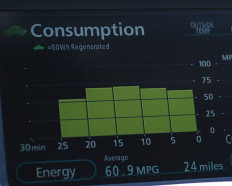Tighter MPG, Emission Rules Go on the Books for 2012

It’s been a long time coming. The Obama administration has just finalized the country’s first ever national regulation to curb greenhouse gas emissions and raise the bar on efficiency requirements for new cars and trucks. The move could push automakers to incorporate more green technology into their lineups, from more efficient fuel-injection systems to start-stop engines to hybrids and all-electric vehicles.
Under the new standards, first proposed last year, manufacturers must achieve an average of at most 250 grams of carbon dioxide per mile for their fleet by the 2016 model year. According to a statement from the Transportation Department this morning, that would mean a fleet average of 35.5 MPG if all of the emission reductions came from improvements in fuel economy (other options might include controlling air conditioner coolant leaks).
The National Highway Traffic Safety Administration (NHTSA), meanwhile, has set fuel economy standards to gradually increase starting with the 2012 model year, reaching 34.1 MPG by 2016. According to DOT, the effect will be to “reduce fleet-wide greenhouse gas emissions by approximately five percent every year.”
As the Detroit Free Press reports, the feds estimate that the new rules will “raise the average price of a new vehicle by less than $1,000 in the 2016 model year.” But the EPA says an average buyer of a 2016 model could potentially save up to $3,000 on fuel over the life of the vehicle.
Federal agencies say they received more than 130,000 public comments in response to their September 2009 proposal for this rule, “with overwhelming support for the strong national policy.” According to a survey from the consumer advocacy group Consumer Federation of America released late last year, just 44 models for the 2010 model year (4 percent of all EPA-rated vehicles for the year) get 30 MPG or more — despite widespread consumer interest in more fuel efficient vehicles.
It’s not just consumers who have backed the uptick in MPG requirements. Environmental groups have supported the regulation, which Transportation Secretary Ray LaHood described today as “the most aggressive fuel economy standard ever set in the United States for car and trucks.”
Car manufacturers got behind the notion of a single national regulation, rather than having separate rules for the Transportation Department, EPA and the 13 states that followed California’s tougher standard. Dave McCurdy, President and CEO of the Automobile Manufacturers Alliance — which represents Toyota, GM, Ford, Mazda, Mitsubishi and other automakers — cheered the new regulation in a statement Thursday, commenting, “A year ago, the auto industry faced a regulatory maze resulting from multiple sets of inconsistent fuel economy/greenhouse gas standards.”
Having a firm idea of what vehicle standards will look like for the next six years is important for automakers weighing investments in green car technology. EPA Administrator Lisa Jackson in a statement today called the program “a win for automakers and drivers, a win for innovators and entrepreneurs, and a win for our planet.”
Whether and how much car companies end up betting on young entrepreneurial ventures for this tech remains to be seen, however. It’s no small feat persuading an automaker to adopt MPG-boosting technology from a company that hasn’t had time to gather data about how their systems function long term. But a slew of startups (like Achates Power, Alphabet Energy, EcoMotors and others in our chart of upstarts building green car tech for a pre-electric world) aim to seize the opportunity in coming months and years.
Of course, plenty of room for improvement remains. The 35.5 MPG standard marks a major step toward cleaning up the U.S. transportation sector and cutting back on fossil fuel consumption. But as McCurdy points out, “now we need to work on 2017 and beyond.”
Photo courtesy of Flickr user Beige Alert
You can return to the main Market News page, or press the Back button on your browser.

